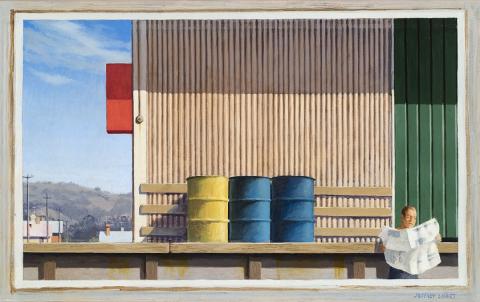SECOND STUDY FOR MORNING, YARRAGON SIDING, 1983
JEFFREY SMART
oil and synthetic polymer paint on card on composition board
40.0 x 63.0 cm
signed lower right: JEFFREY SMART
signed lower left: JEFFREY SMART
Rex Irwin Art Dealer, Sydney (label attached verso)
Private collection, Sydney
Thence by descent
Private collection, Sydney
Jeffrey Smart, Recent Paintings, Rex Irwin Art Dealer, Sydney, 6 – 24 November 1984, cat. 13
McDonald, J., Jeffrey Smart: Paintings of the ’70’s and ’80’s, Craftsman House, Sydney, 1990, p. 160, cat. 262
Morning, Yarragon Siding, 1983 – 84, oil and synthetic polymer paint on canvas, 100.0 x 134.0 cm, formerly in the Holmes à Court collection, Perth
Third Study for Morning, Yarragon Siding, 1983, Parliament House Art Collection, Canberra
The Victorian country town of Yarragon nestles into the foothills of the Strezlecki Ranges. In Second Study for Morning, Yarragon Siding, 1983 Jeffrey Smart gives us a momentary glimpse of its rooftops and gently rolling hills bathed in sunlight, enveloped in an atmosphere so masterfully rendered that it seems tangible. Smart was visiting the area to make landscape studies for the Australian setting chosen for his monumental commission Container Train in Landscape, 1983 – 84 gifted to the Victorian Arts Centre, Melbourne by Marc and Eva Besen. While at Yarragon, the old railway shed on platform two caught Smart’s eye. The results are the oil studies and the larger painting Morning, Yarragon Siding, 1983 – 84, previously in the Holmes à Court collection, Perth.
While Smart’s final paintings are immaculate in composition and finish, as witnessed by the above-mentioned Morning, Yarragon Siding, his oil studies by contrast reveal an absorbingly immediate response to the motif. As such, they are often more personal by being so revealing. The freer application of paint in Second Study for Morning, Yarragon Siding exudes an enthusiasm that refined for the final work. This initial enthusiasm allows him the indulgence of an earlier fascination with texture, of timbers and other constructions, which contrasts starkly with the captivating plein-air quality of the landscape to the left. Painted in the tantalizingly traditional manner of Tom Roberts and the nineteenth-century Australian Impressionists, Smart thus juxtaposes nature with the contemporary world’s hard-edged realism in the siding and its hints of flat surfaced, geometric abstraction. Smart invites us to compare the two as both equally worthy of consideration as good art. And in this second study, even the face of the man reading the newspaper is revealed, while the final version gives way to greater order. Detailed construction and stronger light dominate the landscape; and the lines and corrugations of the railway shed are more pronounced. The balance between verticals and horizontals is developed as a prominent feature of the carefully considered composition; and as the face disappears behind the newspaper, the now impersonalized figure is obliged to adopt the traditional role of being included purely for scale. If the colour composition is more sophisticated, it also has greater formality. Finally, the addition of the large number ‘2’, designating the particular railway siding, provides the artist’s ultimate seal of approval through his happy addiction to including (often enigmatic) words and numbers in his paintings. In music, the study and the finished painting might be likened to a prelude and a concerto. Both are excellent in their individual ways.
DAVID THOMAS
